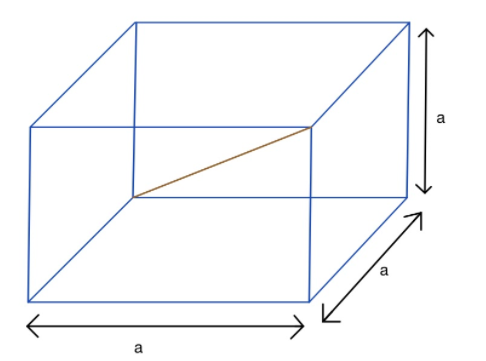
The volume of a cube (in cubic cm) plus three times the total length of its edges ( in cms) is equal to twice its area (in sq. cm). The length of its diagonal is
(A). 6
(B). $$6\sqrt{3}$$
(C). $$3\sqrt{6}$$
(D). $$6\sqrt{6}$$
Answer
588.6k+ views
Hint: In this question it is given that the volume of a cube (in cubic cm) plus three times the total length of its edges ( in cms) is equal to twice its area (in sq. cm). Then we have to find the length of its diagonal. So to understand it in better ways we have to draw the diagram,

So to find the solution, first we have to find the volume and the surface area of the given cube and after that by the given condition we are able to find the length diagonal.
Where, we have to know some formulas,
Volume of a cube(V)=$$\left( \text{side} \right)^{3} $$,......(1)
The total surface area(A)=$$6\times \left( \text{side} \right)^{2} $$.......(2)
And the diagonal of a cube =$$\sqrt{3} \times \text{side}$$.........(3)
Complete step-by-step solution:
Let the side of the cube be a cm,
Now since the cube has 6 faces and each face is a square of side a cm.
Therefore, for the 6 faces area will be, $$A=6a^{2}\ cm^{2}$$,
Then the total surface area of a cube $$(A)=a^{2}\ cm^{2}$$........(1)
And the volume$$(V)=a^{3}\ cm^{2}$$........(2)
Now as we can see a cube has 12 edges and each of length a.
Then we can say that the total length of its edges(S)=12a cm…..(3)
In the question it is given, the volume of a cube (in cubic cm) plus three times the total length of its edges ( in cms) is equal to twice its area (in sq. cm),
i,e $$V+3S=2A$$..........(4)
Now by putting the value of V, S an A in equation (4), we get,
$$a^{3}+3\left( 12a\right) =2\left( 6a^{2}\right) $$
$$\Rightarrow a^{3}+36a=12a^{2}$$
$$\Rightarrow a^{3}-12a^{2}+36a=0$$
$$\Rightarrow a(a^{2}-12a+36)=0$$
$$\Rightarrow a(a^{2}-2\cdot a\cdot 6+6^{2})=0$$
Now as we know that $$\left( x-y\right)^{2} =x^{2}-2xy+y^{2}$$,
So by using the identity, we can write the above equation as,
$$a\left( a-6\right)^{2} =0$$
$$a\left( a-6\right) \left( a-6\right) =0$$
Therefore, either, a=0, which is not possible.
Or, $$a-6=0\Rightarrow a=6$$
Therefore, the diagonal of a cube= $$\sqrt{3} a$$
=$$\sqrt{3} \times 6$$ cm
=$$6\sqrt{3}$$ cm
Hence the correct option is option B.
Note: You might be thinking how can we get the expression for surface area, so let's find it.
As we know that a cube has 6 surfaces and each surface is in the shape of a square, where the length of each edge is a. Then you can easily say that the area of this surface is $$a^{2}$$, so from here we can easily find the total surface area is 6 times of the area of one surface, i.e, $$a^{2}$$. Also you have to know that, all the diagonals of a cube are equal.

So to find the solution, first we have to find the volume and the surface area of the given cube and after that by the given condition we are able to find the length diagonal.
Where, we have to know some formulas,
Volume of a cube(V)=$$\left( \text{side} \right)^{3} $$,......(1)
The total surface area(A)=$$6\times \left( \text{side} \right)^{2} $$.......(2)
And the diagonal of a cube =$$\sqrt{3} \times \text{side}$$.........(3)
Complete step-by-step solution:
Let the side of the cube be a cm,
Now since the cube has 6 faces and each face is a square of side a cm.
Therefore, for the 6 faces area will be, $$A=6a^{2}\ cm^{2}$$,
Then the total surface area of a cube $$(A)=a^{2}\ cm^{2}$$........(1)
And the volume$$(V)=a^{3}\ cm^{2}$$........(2)
Now as we can see a cube has 12 edges and each of length a.
Then we can say that the total length of its edges(S)=12a cm…..(3)
In the question it is given, the volume of a cube (in cubic cm) plus three times the total length of its edges ( in cms) is equal to twice its area (in sq. cm),
i,e $$V+3S=2A$$..........(4)
Now by putting the value of V, S an A in equation (4), we get,
$$a^{3}+3\left( 12a\right) =2\left( 6a^{2}\right) $$
$$\Rightarrow a^{3}+36a=12a^{2}$$
$$\Rightarrow a^{3}-12a^{2}+36a=0$$
$$\Rightarrow a(a^{2}-12a+36)=0$$
$$\Rightarrow a(a^{2}-2\cdot a\cdot 6+6^{2})=0$$
Now as we know that $$\left( x-y\right)^{2} =x^{2}-2xy+y^{2}$$,
So by using the identity, we can write the above equation as,
$$a\left( a-6\right)^{2} =0$$
$$a\left( a-6\right) \left( a-6\right) =0$$
Therefore, either, a=0, which is not possible.
Or, $$a-6=0\Rightarrow a=6$$
Therefore, the diagonal of a cube= $$\sqrt{3} a$$
=$$\sqrt{3} \times 6$$ cm
=$$6\sqrt{3}$$ cm
Hence the correct option is option B.
Note: You might be thinking how can we get the expression for surface area, so let's find it.
As we know that a cube has 6 surfaces and each surface is in the shape of a square, where the length of each edge is a. Then you can easily say that the area of this surface is $$a^{2}$$, so from here we can easily find the total surface area is 6 times of the area of one surface, i.e, $$a^{2}$$. Also you have to know that, all the diagonals of a cube are equal.
Recently Updated Pages
Master Class 8 Social Science: Engaging Questions & Answers for Success

Master Class 8 Maths: Engaging Questions & Answers for Success

Master Class 8 Science: Engaging Questions & Answers for Success

Class 8 Question and Answer - Your Ultimate Solutions Guide

Master Class 8 English: Engaging Questions & Answers for Success

Why are manures considered better than fertilizers class 11 biology CBSE

Trending doubts
What is BLO What is the full form of BLO class 8 social science CBSE

Citizens of India can vote at the age of A 18 years class 8 social science CBSE

Full form of STD, ISD and PCO

Right to vote is a AFundamental Right BFundamental class 8 social science CBSE

What is the difference between rai and mustard see class 8 biology CBSE

Summary of the poem Where the Mind is Without Fear class 8 english CBSE





